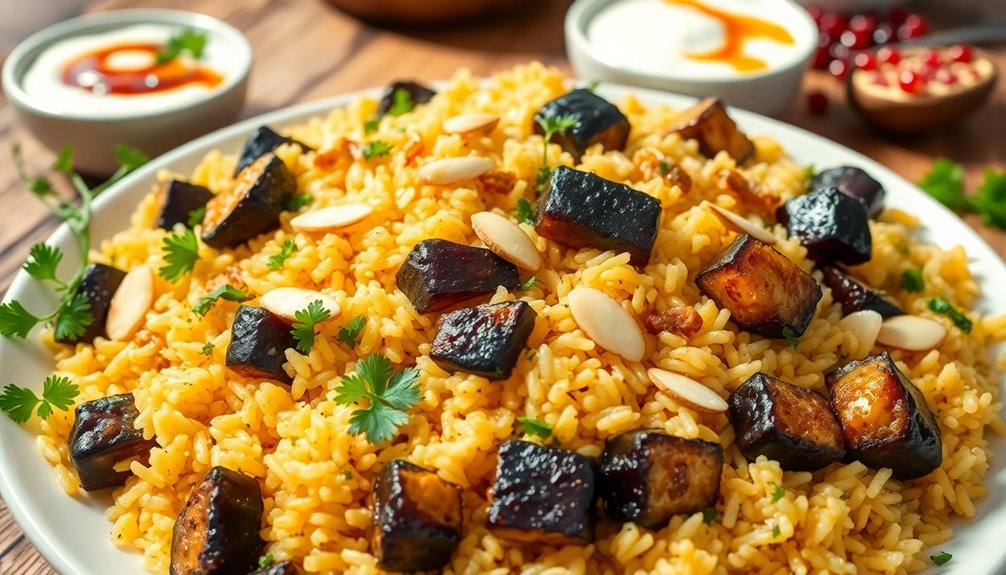Pilaf with eggplant is a tasty, vegetarian dish that combines sautéed eggplant with fluffy basmati rice. To make it, you'll salt and drain the eggplant, then sauté it with onion and garlic until tender. Stir in spices and soaked rice, cook it all together, and finish with fresh herbs for a burst of flavor. This gluten-free option suits various diets and pairs beautifully with grilled meats. There's even more to discover about enhancing this dish's flavors.
History
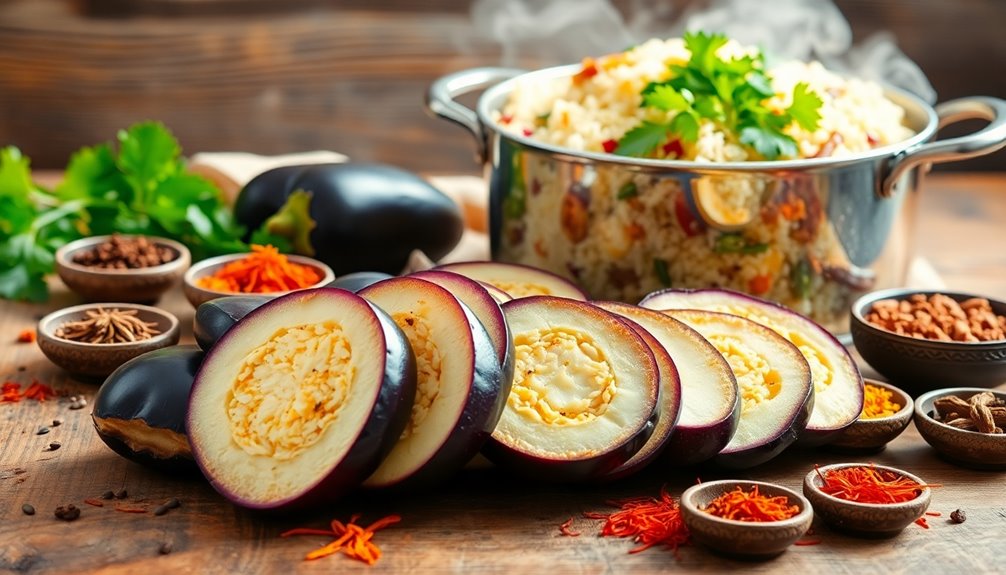
While pilaf traces its origins to the Middle East, it's fascinating how this cooking method has evolved across cultures, particularly in Greek cuisine where eggplant plays a starring role.
Historical records reveal that pilaf made its way to Europe through trade routes, gaining popularity in Greece. Here, local ingredients like eggplant and olive oil enhanced the dish, reflecting the region's agricultural practices.
Greek melitzanopilafo showcases the Byzantine influence, emphasizing seasonal vegetables and grains. The combination of rice and eggplant not only highlights Mediterranean flavors but also represents the fusion of techniques from Persian, Turkish, and Arab cuisines. Additionally, the dish's nutritional value can be enhanced by incorporating key nutrients essential for brain development, which aligns with the health-conscious trends in modern cooking.
Each culture added its touch, creating a delicious legacy that continues to thrive today in many kitchens.
Recipe
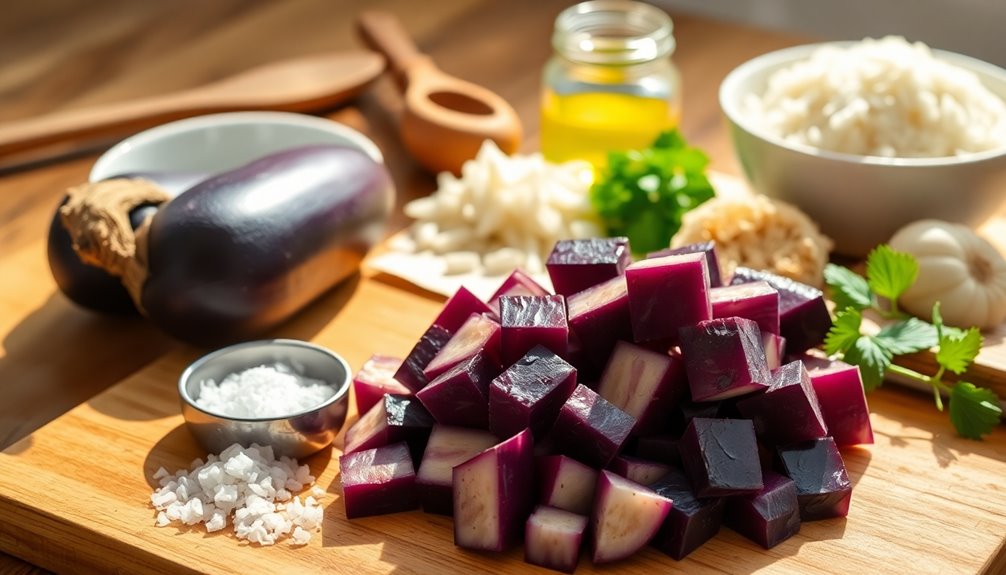
Melitzanopilafo is a traditional Greek dish that beautifully combines the rich flavors of sautéed eggplant and aromatic basmati rice. This hearty pilaf isn't only a vegetarian delight but also a versatile dish that can be served as a main course or as a side.
The key to achieving the perfect texture and flavor lies in the careful preparation of the eggplant and the soaking of the rice, which ensures that each grain cooks evenly and absorbs the delicious spices and tomato sauce.
To make this dish, you'll start by salting and draining the cubed eggplants to draw out their bitterness, ensuring a pleasant taste. Once the eggplants are sautéed to a lovely golden brown, they'll be combined with soaked basmati rice, tomatoes, and a blend of spices.
The mixture will then be simmered gently until the rice is tender and fluffy, allowing all the flavors to meld together. Finally, finish the dish with a sprinkle of fresh herbs for an added burst of freshness.
Ingredients:
- 2 medium eggplants, cubed
- 1 cup basmati rice, soaked for 30 minutes
- 2 tablespoons olive oil
- 1 onion, finely chopped
- 2 cloves garlic, minced
- 2 tomatoes, chopped
- 2 cups vegetable stock
- 1 teaspoon ground cumin
- 1 teaspoon paprika
- Salt and pepper to taste
- Fresh mint and parsley, chopped (for garnish)
Cooking Instructions:
In a large skillet, heat the olive oil over medium heat and sauté the chopped onion and minced garlic until softened and fragrant.
Add the salted and drained eggplant cubes to the skillet, cooking until they're lightly browned and tender. Stir in the chopped tomatoes, cumin, paprika, salt, and pepper, and cook for a few more minutes.
Add the soaked basmati rice and vegetable stock, bringing the mixture to a boil before reducing the heat to low. Cover and simmer for about 20 minutes or until the rice is fluffy and has absorbed all the liquid.
Once cooked, gently fluff the rice with a fork and stir in the fresh herbs.
Extra Tips:
When salting the eggplant, ensure you let it sit for at least 30 minutes to fully draw out the bitterness; rinse and pat dry afterward to remove excess moisture.
You can customize this dish by adding other vegetables or legumes for extra nutrition. For an added depth of flavor, consider using homemade vegetable stock or infusing the oil with spices before cooking the onions and garlic. Additionally, incorporating sustainable sourcing practices in your ingredient selection can enhance both the quality and environmental impact of your meal.
Finally, don't hesitate to adjust the spices to suit your taste, and serve it with a side of yogurt or grilled meats for a more complete meal experience.
Cooking Steps
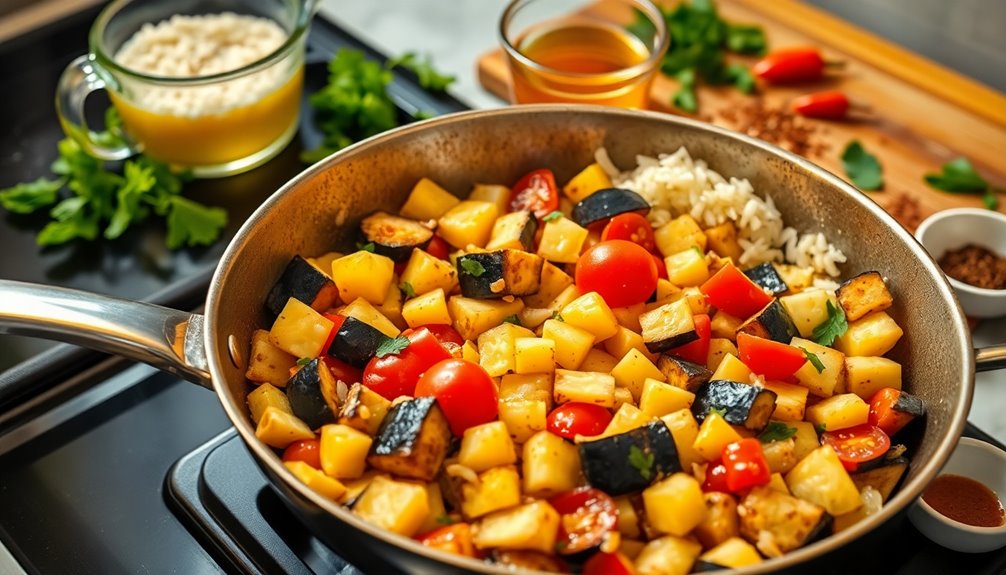
To get started on your pilaf, chop the eggplant into small cubes and sauté them until they're golden brown.
Next, add your favorite spices and herbs for flavor, then stir in the cooked rice.
Finish off by garnishing with fresh herbs for that perfect touch before serving. Including vegetables like eggplant not only adds flavor but also boosts the dish's nutritional value.
Step 1. Chop Eggplant Into Small Cubes
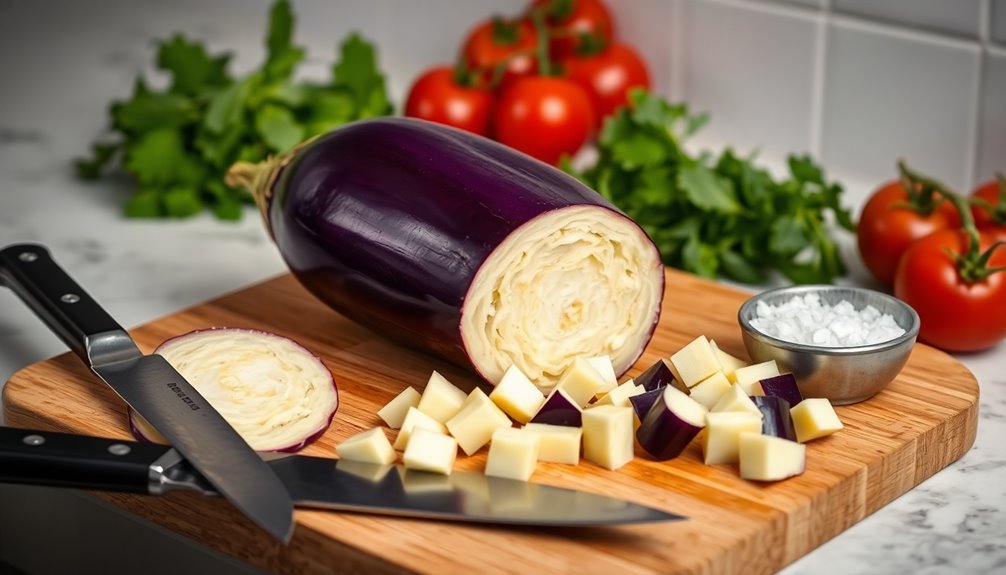
Begin by cutting the eggplant into large cubes, leaving the skin on for added flavor and texture.
Make sure your eggplant cubes are uniform in size, which helps ensure even cooking in your pilaf.
Next, place them in a colander and sprinkle liberally with salt. This step draws out excess moisture and bitterness.
Let the salted eggplant sit for 30 minutes before rinsing and drying it thoroughly with paper towels. This process removes any residual salt and moisture, preparing the eggplant cubes for cooking.
If you like, you can toss the cubes in a bit of olive oil for extra flavor.
Now you're ready to sauté or roast them over medium heat, enhancing their taste in your pilaf. Additionally, using herbal teas like chamomile can promote relaxation while you cook.
Step 2. Sauté Eggplant Until Golden
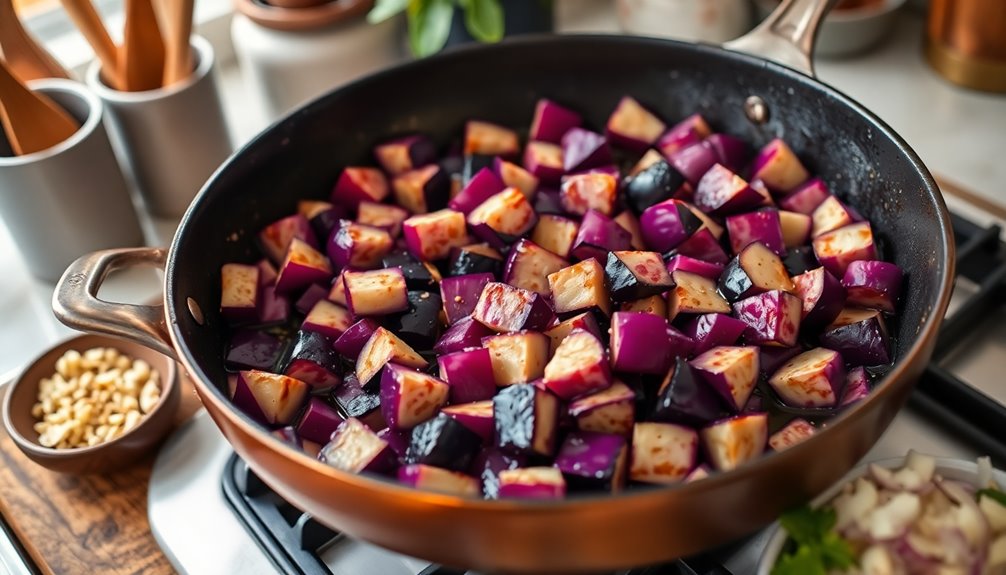
Once your eggplant cubes are prepped and dried, heat some olive oil in a heavy pan over medium heat until it shimmers.
Carefully add the eggplant cubes in a single layer, making sure not to overcrowd the pan. Sauté the eggplant for about 8-10 minutes, turning occasionally to ensure even cooking. You want them to become lightly browned and tender without steaming.
If necessary, cook in batches to achieve that perfect golden color. As they sauté, the eggplant will absorb the olive oil and develop a rich flavor. It's worth noting that the nutrient density of vegetables like eggplant can contribute to a healthier diet.
Once they're golden and cooked through, set the sautéed eggplant aside. You'll soon incorporate them into your delicious pilaf or other dishes for added depth and texture.
Step 3. Add Spices and Herbs
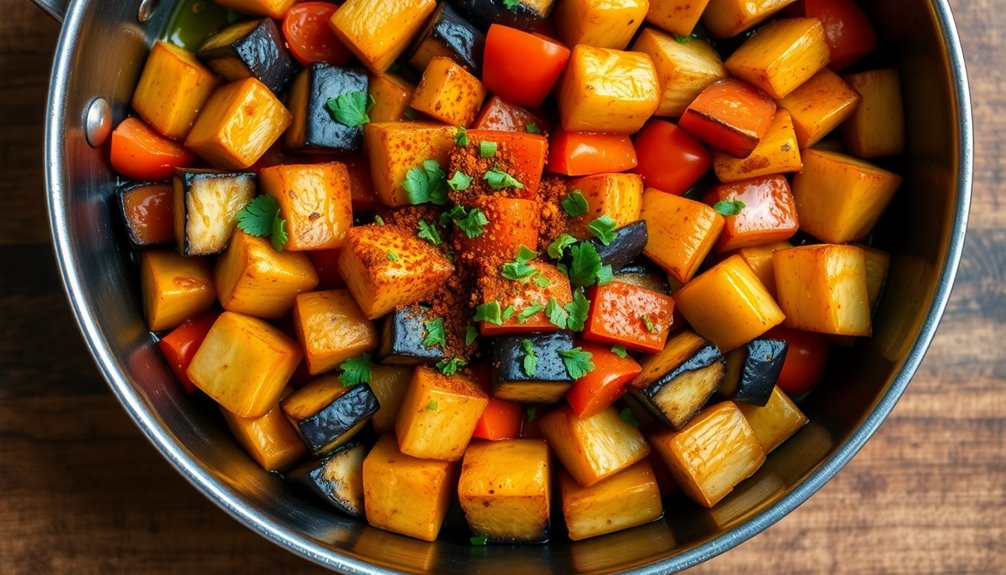
Adding spices and herbs transforms your eggplant pilaf into a fragrant and flavorful dish.
Begin by adding a mix of spices such as black pepper, coriander, turmeric, and cumin. These will give your pilaf a warm, aromatic taste. For those who enjoy a bit of heat, sprinkle in some red chili flakes.
Don't forget to toss in a couple of bay leaves; they'll infuse the pilaf with a subtle earthy aroma. About five minutes before you finish cooking, stir in fresh herbs like oregano and parsley to maintain their vibrant color and flavor.
Finally, a splash of lime juice will brighten the dish, balancing the richness of the eggplant and enhancing the spices. To elevate the dish further, consider serving it alongside some crusty bread to complement the flavors. Enjoy your delicious creation!
Step 4. Stir in Cooked Rice
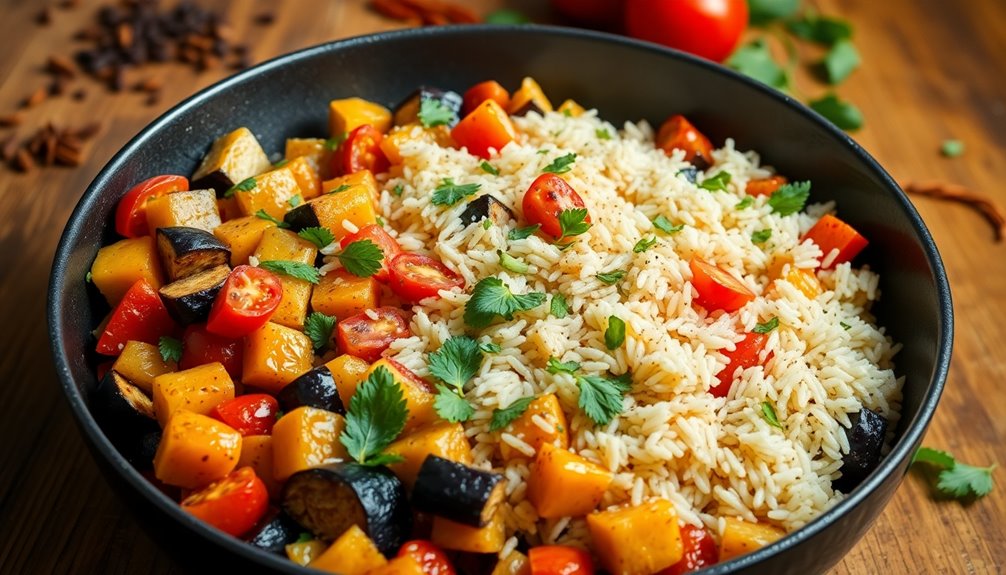
Carefully layer the soaked and drained rice on top of the cooked eggplant and onion mixture in your pan.
Don't stir just yet; this allows the rice to absorb the flavors.
Next, add enough liquid—about 1.5 to 2 times the volume of the rice—to ensure proper cooking.
Bring the mixture to a boil without stirring, then reduce the heat and cover the pan.
Let it simmer gently for about 20 minutes, ensuring even cooking and preventing burning.
After cooking, remove the pan from heat and let it rest for a few minutes with a paper towel over the rim to trap steam.
This step will give you fluffy rice, making your rice recipe even more delightful. Additionally, using different brewing methods can enhance the flavors in your meal preparation by creating a coffee blend that pairs well with your dish.
Step 5. Garnish With Fresh Herbs
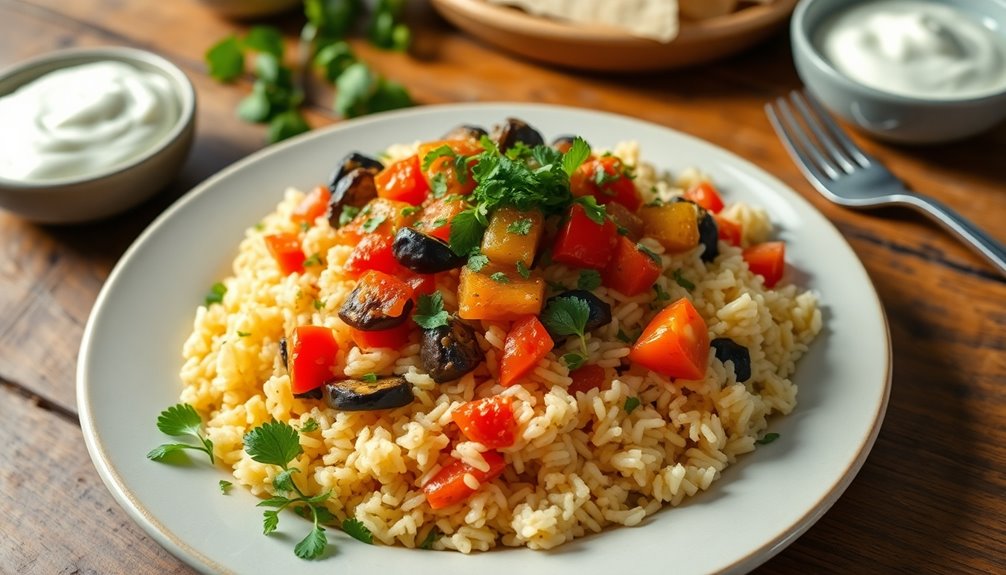
As you approach the final stages of your pilaf, incorporating fresh herbs can really elevate the dish. About five minutes before you remove the pilaf from heat, toss in a handful of chopped parsley, oregano, or mint.
These fresh herbs not only enhance the flavor of the eggplant but also add a vibrant color contrast that makes your dish visually appealing. A sprinkle of chopped mint just before serving brings a refreshing taste that complements the richness of the eggplant and olive oil.
While you can mix in some dried herbs for depth, remember to save the fresh ones for garnishing. This simple step transforms your pilaf into a truly inviting meal! Additionally, the use of fresh herbs can improve the overall color accuracy of your dish, making it even more appetizing to the eye.
Final Thoughts
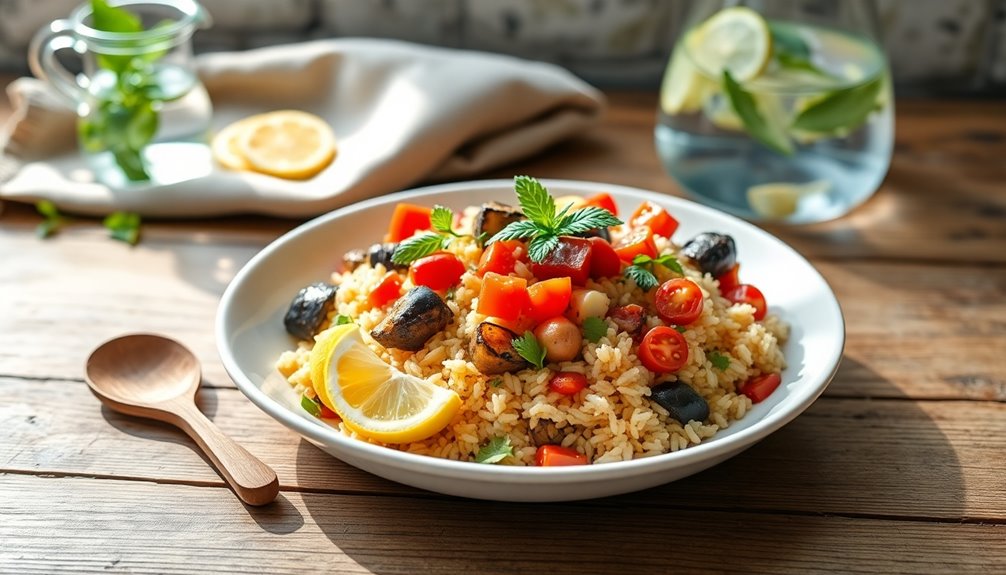
While you might think pilaf is just a simple rice dish, incorporating eggplant takes it to another level, offering a delightful blend of flavors and textures.
By sautéing or roasting eggplant, you create a rich taste that complements your choice of rice, whether it's basmati or bulgur. This dish isn't just delicious; it's also gluten free, making it suitable for various dietary preferences.
Fresh herbs like mint or parsley add a burst of freshness just before serving, enhancing the overall flavor profile. Additionally, using eco-friendly materials in your kitchen can contribute to a more sustainable cooking experience.
Whether you serve it as a vegetarian main course or a side with grilled meats, eggplant pilaf proves to be a versatile, satisfying option that'll impress everyone at your table.
Enjoy every bite!
Frequently Asked Questions
What Makes a Pilaf a Pilaf?
A pilaf's unique because of its cooking technique. You sauté the rice in fat, like olive oil, before simmering it in a seasoned liquid, ensuring each grain stays separate and fluffy.
This method allows the rice to absorb flavors fully, making it rich and delicious.
You can customize a pilaf with various ingredients like vegetables, meats, or legumes, adapting it to your tastes and dietary needs, which adds to its versatility.
Why Do You Soak Eggplant in Water Before Cooking?
Soaking eggplant in salted water is like choosing between a soggy sponge and a perfectly tender dish. You draw out excess moisture, reducing bitterness and improving texture.
This simple step also prevents the eggplant from soaking up too much oil during cooking, making your meal lighter. Plus, it lets you keep the skin on, preserving nutrients and flavor.
A quick 30 minutes of soaking and rinsing can make a world of difference in your dish!
What Does Eggplant Pair Well With?
Eggplant pairs well with a variety of ingredients, enhancing your dishes' flavors.
You'll find that it complements Mediterranean staples like tomatoes, garlic, and fresh herbs. Tangy additions, such as yogurt or feta, beautifully balance its creamy texture.
Spices like cumin and smoked paprika also add depth. Plus, it works great with proteins like chicken, lamb, or fish, making your meals hearty and satisfying when combined with grains like rice or bulgur.
What Is the Difference Between Pilaf and Plov?
Imagine you're preparing a cozy dinner.
The difference between pilaf and plov lies primarily in their cooking methods. When you make pilaf, you sauté rice separately in fat, resulting in fluffy grains.
In contrast, if you cook plov, you combine rice, meat, and spices in one pot, allowing the rice to absorb all those rich flavors, making it stickier.
Conclusion
As you savor each bite of your pilaf with eggplant, you might find yourself wondering—what's the secret that makes this dish so irresistible? It's the harmony of spices, the tender eggplant, or perhaps the rich history woven into every ingredient. With each forkful, you're not just tasting a meal; you're experiencing a story. So, what will your next culinary adventure be? The kitchen awaits, and the possibilities are endless—dare you explore them?
